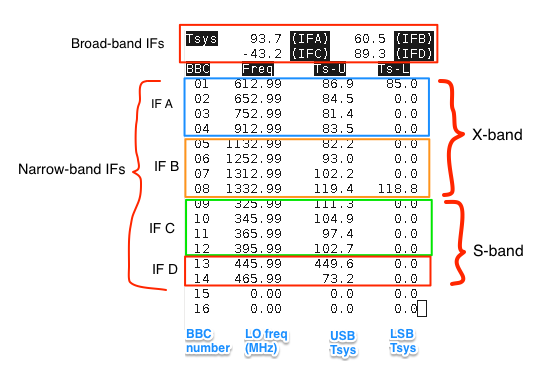User Tools
Sidebar
This wiki is not maintained! Do not use this when setting up AuScope experiments!
System Temperature Check
A good check of the health of the receiver system is a System Temperature (Tsys) check. This can be run from the Operator Input window with the command
systemp12
Tsys values are reported after about 15 seconds. Expected values are given in the checklist. If they are unusually high, there could be water (condensation) on the feed window or overcast conditions can raise the Tsys. If you suspect a wet feed window, try another Tsys measurement with the antenna tipped to say 20 degrees elevation (but only after the Antenna checks have been made).
Tsys measurements can be found in the SysMon group in the e-RemoteCtrl window; however, these are currently formatted strangely. To view the correct output, open an ssh connection to the fs computer and run monit3.
monit3 output
Below is an annotated copy of monit3 output for Hb:
Tsys is measured in each of the four DBBC input bands in two ways:
- Across the whole (up to) 512 MHz band without filtering, i.e. broad-band Tsys
- Across each of the 16 recorded bands (usually 8 or 16 MHz wide), i.e. narrow-band Tsys
The top four numbers show the broad-band Tsys values in K. In most cases IFA and IFB are the two X-band inputs and IFC and IFD are S-band.
The table below shows the Tsys for each recorded band. A value of 0.0 means no data. In some cases (in this example, in BBCs 1 and 8) both Upper and Lower Side-Band (USB and LSB) are recorded but in most cases only USB is recorded.
If there is interference then the broad-band Tsys values can be affected, but only the narrow band IFs with interference in their frequency range should show a bad value. In the example here, S-band is affected by interference as can be seen by the negative broadband value for IFC and very high number in BBC-13. The autocorrelation plots give a hint to where the interference is.

